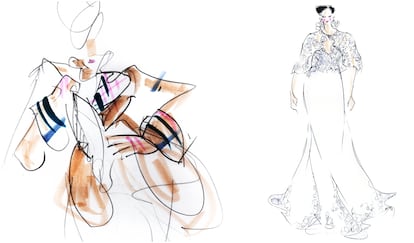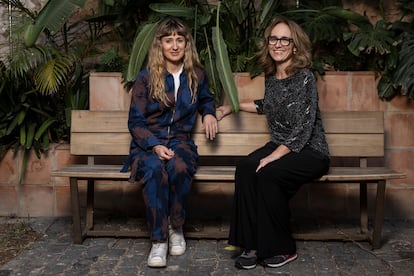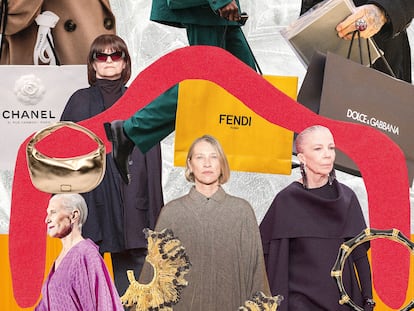‘Sketching Fashion’: A look at more than 500 years of the history of fashion illustration
From the walls of the Egyptian pyramids to the illustrators of today, Laia Beltran and Lucy Victoria Davis reclaim the value of couture drawing as art in a book full of documentary and anecdotal information

“The stroke of a pencil or a piece of thread can change the world,” says fashion journalist Laia Beltran, sitting under the lemon trees of the inner courtyard of a well-known bookstore in the Raval neighborhood of Barcelona. “The phrase is Miró's, but we made it ours,” adds the graphic designer and fashion illustrator Lucy Victoria Davis. Both agree that fashion, as an artistic discipline, is undervalued, perceived as something frivolous. “Why is the plan of a building more talented than the pattern of a jacket?” Beltran questions. With the aim of reclaiming fashion as a major art, they created the book Sketching Fashion, a journey through the history of fashion illustration, accompanied by a compilation of biographies of contemporary illustrators.
When Beltran was preparing a history of illustration class for the IDEP School of Image and Design, in Barcelona, she thought that it was a good idea for her students to meet an illustrator to learn how to express their ideas; that is when Davis came into the picture. Two years and one pandemic later, Sketching Fashion saw the light, with a clear didactic mission. “A lot of people think that men have always worn shirts and pants. It’s a shame that the educational curriculum doesn’t include these contents,” says Beltran. The first part of the book is a historical overview of fashion illustration that avoids the sobriety of the essay, opting for “nuggets of knowledge,” instead: a format that combines documentary and anecdotal information, with illustrations from each historical era. A “simple” reference manual that cannot be missing from the bibliography of any fashion student.
“One can get to know a society through its way of dressing,” explains Beltran while pointing to an Egyptian model. “This is a kalasiris, the flagship garment in ancient Egypt, a colorful tunic made of linen – one of the main crops on the banks of the Nile – suitable for high temperatures.” The history of fashion is as old as that of civilization. The first illustrations rest on the walls of Egyptian pyramids and temples, and their descriptive value has made them a key element for archaeological research.

The documentary role of clothing has remained present throughout the centuries. During the Middle Ages, illustrators traveled throughout Europe to capture the customs and the appearance of different kingdoms. Their drawings were collected in the so-called costume codices, such as the Trachtenbuch (Nuremberg, 1529), a compilation of 154 hand-colored drawings in watercolor, tempera and gold and silver metallic inks. After the popularization of the printing press, the codices were replaced by costume books: collections of engravings made with an informative purpose, which, unlike the portraits, also show the clothing and appearance of the lower classes.
“Gradually, clothing takes center stage in illustration,” says Davis. “The perfect example is the appearance of the first influencer in history, in the 16th century,” she adds. For 40 years, Matthäus Schwarz, an upper-class German gentleman, had himself painted 137 times by different artists who drew his outfits. “He wanted to record what he wore; along with the drawings, he added a description of the clothes, in his own handwriting.”

In the 19th century, the taste for aesthetic pleasure gave rise to the ancestors of Vogue, with fashion magazines such as the French Mercure Galant. “For the men, tights to match the suit and little black shoes with golden straps. For the women, embroidered chiffon caps and shirt sleeves with knit cuffs,” Beltran reads. “They intend to create trends, describing what the wealthy classes wear in order to make it an object of admiration in all social strata,” she explains.
Fashion and art in the 20th century: A turning point
At the beginning of the 20th century, like any artistic discipline, fashion abandoned realism and began to draw on the avant-garde. “Paul Poiret was the culprit; with his illustrations, the artist freed women from corsets and corseting fashion,” they say. Cubism, futurism and art deco come into fashion, and with them, interpretation. Fashion abandons its descriptive role and becomes an art, with great influence on the canons of beauty. “The illustrations not only depicted the most beautiful upper-class women; they are made from the male perspective,” Beltran denounces.
The configuration of the ideal of beauty matched the emerging consumer society perfectly and fashion illustration fused with the world of advertising, a love story that lasts to this day. “With the appearance of photography, illustration took a backseat, but in the last decade the big fashion houses and magazines have once again turned to drawing as a personalized, more laborious, exclusive photograph,” says Davis. “Style illustration is back to stay; it currently is a sector with many professional opportunities.”
The second part of the book is a snapshot of the current panorama of the field of illustration. Selecting 21 illustrators was not easy: “We wanted gender parity, generational difference, emerging and established artists, like David Downton or Jordi Labanda. We also looked for different styles – Richard Haines is totally handmade, while Malika Favre is 100% digital – and a diversity of techniques, such as Prince Lauder’s collages and Ángel Hernández’ architectural element.” The goal of presenting these artists’ biographies and advice is to offer a source of inspiration and education for those who are entering the world of fashion illustration. “It’s a way to get to know them more closely, to see their creative processes before developing your own style,” says Davis. The authors also invite readers to do more than just read and become part of a community to exchange ideas and projects on an Instagram account they created with the same name as the book: Sketching Fashion.

“There are no secrets in this profession. Just keep going. And going. And going,” the famous Hungarian fashion illustrator Gladys Perint Palmer advises in the pages of Sketching Fashion. “I learned to draw before I mastered walking,” says the illustrator, who has worked for Harper’s Bazaar and The New Yorker and is one of the first recognized female figures in the field. “Women have always been present in the world of illustration, but, as in other fields, history has not been fair to them, and their names have not remained for posterity,” says Beltran. “It’s as if they never existed, and their contribution to fashion illustration deserves to be recognized. It would be enough for a whole other book.”
Sign up for our weekly newsletter to get more English-language news coverage from EL PAÍS USA Edition
Tu suscripción se está usando en otro dispositivo
¿Quieres añadir otro usuario a tu suscripción?
Si continúas leyendo en este dispositivo, no se podrá leer en el otro.
FlechaTu suscripción se está usando en otro dispositivo y solo puedes acceder a EL PAÍS desde un dispositivo a la vez.
Si quieres compartir tu cuenta, cambia tu suscripción a la modalidad Premium, así podrás añadir otro usuario. Cada uno accederá con su propia cuenta de email, lo que os permitirá personalizar vuestra experiencia en EL PAÍS.
¿Tienes una suscripción de empresa? Accede aquí para contratar más cuentas.
En el caso de no saber quién está usando tu cuenta, te recomendamos cambiar tu contraseña aquí.
Si decides continuar compartiendo tu cuenta, este mensaje se mostrará en tu dispositivo y en el de la otra persona que está usando tu cuenta de forma indefinida, afectando a tu experiencia de lectura. Puedes consultar aquí los términos y condiciones de la suscripción digital.
More information
Archived In
Últimas noticias
Most viewed
- Alain Aspect, Nobel laureate in physics: ‘Einstein was so smart that he would have had to recognize quantum entanglement’
- The US bombing of Venezuela, in pictures
- Oil, gold and rare earth elements: the backdrop to US political tension with Venezuela
- Maps of the US attack on Venezuela: Targets, airspace and deployed fleet
- Delta Force, the elite US military unit that captured Maduro











































